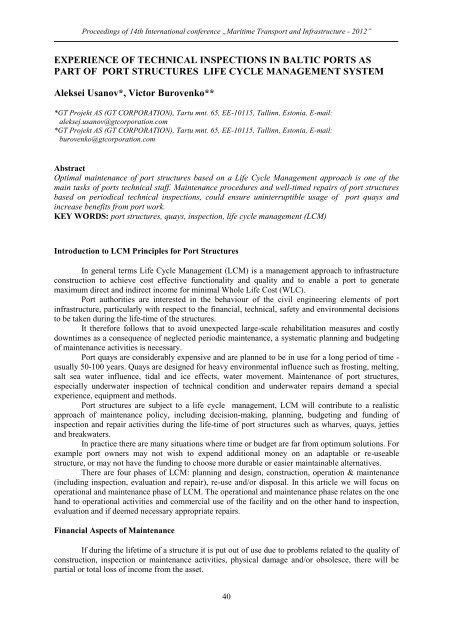14. starptautiskÄ konference 2012 - Latvijas JÅ«ras akadÄmija
14. starptautiskÄ konference 2012 - Latvijas JÅ«ras akadÄmija
14. starptautiskÄ konference 2012 - Latvijas JÅ«ras akadÄmija
You also want an ePaper? Increase the reach of your titles
YUMPU automatically turns print PDFs into web optimized ePapers that Google loves.
Proceedings of 14th International conference „Maritime Transport and Infrastructure - <strong>2012</strong>”EXPERIENCE OF TECHNICAL INSPECTIONS IN BALTIC PORTS ASPART OF PORT STRUCTURES LIFE CYCLE MANAGEMENT SYSTEMAleksei Usanov*, Victor Burovenko***GT Projekt AS (GT CORPORATION), Tartu mnt. 65, EE-10115, Tallinn, Estonia, E-mail:aleksej.usanov@gtcorporation.com*GT Projekt AS (GT CORPORATION), Tartu mnt. 65, EE-10115, Tallinn, Estonia, E-mail:burovenko@gtcorporation.comAbstractOptimal maintenance of port structures based on a Life Cycle Management approach is one of themain tasks of ports technical staff. Maintenance procedures and well-timed repairs of port structuresbased on periodical technical inspections, could ensure uninterruptible usage of port quays andincrease benefits from port work.KEY WORDS: port structures, quays, inspection, life cycle management (LCM)Introduction to LCM Principles for Port StructuresIn general terms Life Cycle Management (LCM) is a management approach to infrastructureconstruction to achieve cost effective functionality and quality and to enable a port to generatemaximum direct and indirect income for minimal Whole Life Cost (WLC).Port authorities are interested in the behaviour of the civil engineering elements of portinfrastructure, particularly with respect to the financial, technical, safety and environmental decisionsto be taken during the life-time of the structures.It therefore follows that to avoid unexpected large-scale rehabilitation measures and costlydowntimes as a consequence of neglected periodic maintenance, a systematic planning and budgetingof maintenance activities is necessary.Port quays are considerably expensive and are planned to be in use for a long period of time -usually 50-100 years. Quays are designed for heavy environmental influence such as frosting, melting,salt sea water influence, tidal and ice effects, water movement. Maintenance of port structures,especially underwater inspection of technical condition and underwater repairs demand a specialexperience, equipment and methods.Port structures are subject to a life cycle management, LCM will contribute to a realisticapproach of maintenance policy, including decision-making, planning, budgeting and funding ofinspection and repair activities during the life-time of port structures such as wharves, quays, jettiesand breakwaters.In practice there are many situations where time or budget are far from optimum solutions. Forexample port owners may not wish to expend additional money on an adaptable or re-useablestructure, or may not have the funding to choose more durable or easier maintainable alternatives.There are four phases of LCM: planning and design, construction, operation & maintenance(including inspection, evaluation and repair), re-use and/or disposal. In this article we will focus onoperational and maintenance phase of LCM. The operational and maintenance phase relates on the onehand to operational activities and commercial use of the facility and on the other hand to inspection,evaluation and if deemed necessary appropriate repairs.Financial Aspects of MaintenanceIf during the lifetime of a structure it is put out of use due to problems related to the quality ofconstruction, inspection or maintenance activities, physical damage and/or obsolesce, there will bepartial or total loss of income from the asset.40
















